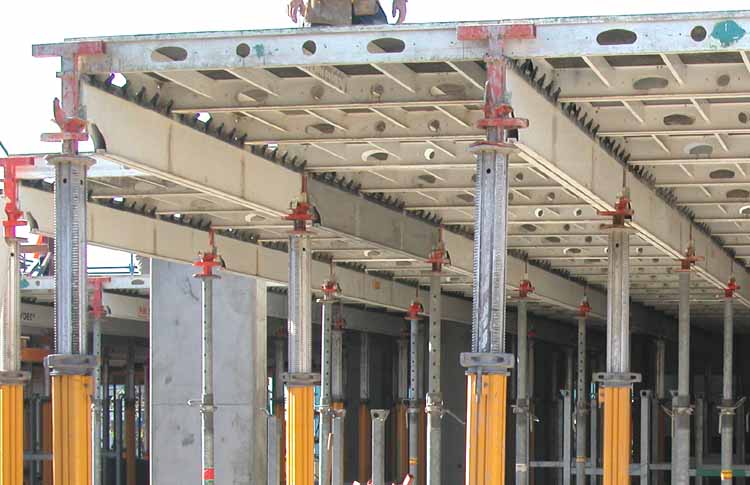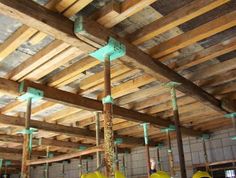The aim of this Method Statement is to provide and maintain effective quality control procedures and to execute the construction work in compliance to standard and good practice at all stages and activities for the Erection & Dismantling of the Slab Formwork for Water Tanks. Following equipment’s and tools will be used as required during the formwork erection.
- Hammer
- Spinner set
- Ventilation Fans
- Gas detector
- Lighting Equipment / Arrangements
- Crane
- Trained Personnel for Confined Space Entry
METHOD / PROCEDURE:
General:
Formwork shall be so constructed that it will support the loads imposed on it by fresh concrete together with additional stresses imposed by vibrating equipment and by construction traffic.
For the construction of structural floor slabs formwork shall be used as per shop drawings and manufacturer’s recommendations. The cup-lock system will be erected on a load bearing horizontal base.
CUP LOCK FORMWORK SYSTEM:
The statutory regulations and codes of practices detail common sense requirements and scaffolds shall be constructed in accordance with BS EN 12810-1:2003 & BS EN 12811-2:2003 codes of practice.
- Materials will be stocked within our storage area and will be used as per the site requirements.
- Materials will be set out in the relevant working areas by operatives.

Erection of scaffolding:
The erection procedure will be such that at no time is any unstable or unsafe scaffold left standing. All scaffolders will be working to SG4 standard ( Minimum 3 Boards, Single Guardrail & harness clipped to scaffold when working in an exposed area)
- All scaffolds should be erected on solid ground. Base plates or adjustable base jacks must be used.
- The Cup-lock system scaffold will be used for Access works whereby vertical standards are joined together by horizontal ledgers and fixed by means of a locking cup.
- The base lift will be erected first and then followed by a secondary lift, generally at a height of 2m. Bracing of both facade and ledger provides stability by using galvanized scaffold tube and couplers.
- Intermediate transoms (board supports) are then placed laterally between the ledgers generally spaced at 1.25m. With the use of 50mm scaffold boards the transoms can be spaced at 1.8m centers.
- A minimum of 3 scaffold boards wide are then placed from below onto the transoms
- Scaffolders can then access the platform by means of a ladder; they will fix the outside guardrails before fully boarding the remainder of the platform.
Tagging:
- As the scaffolding is erected a red “Do not use scaffold tag” will be placed in clear view.
- This erection process is then repeated as per the required scaffold height. Ladders which project above the working platform by 1m, unless an alternative hand hold is provided, and will be secured twice using nylon lashing.
- Once complete the scaffold will be inspected by a competent inspector, once satisfied a green Scafftag will be inserted into the holder at the initial ladder access meaning the scaffold can be used.
- The information is then added to the Scafftag register and the scaffold is re-inspected on a 7 day cycle or after any adaption, alteration or any event which may affect the stability of the scaffold.
Fixing of Girders & Sheets:
After vertical erection of shoring tower to its required location, the primary girders and secondary girders will be provided on the cross head spindles. Above the secondary girders 18 mm thick plywood sheets will be provided and fixed on top.
Access:
Suitable access shall be provided to and between the formwork. Access shall be provided by portable ladders / hook on ladders / attachable ladders or stair way type ladders. Scaffolding erection team can then access the platform. They will fix the outside guardrails before fully boarding the remainder of the platform. All ladders shall be secured against displacement.
Assigning Personnel:
Competent person shall be assigned for the formwork selection, erection, use, movement, alteration, dismantling, maintenance and inspection. Only assigned and trained personnel shall be deployed to work. It will be ensured that the user is aware of the fall protection methods, belts and full harness, life lines, rope etc.
Training:
Assigned employees shall receive instruction on the particular type of formwork that they are going to use. In the training it will be ensured that focus is given for proper erection, handling, use, inspection, removal and care. Training shall also include the installation of fall protection.
Site management personnel should also be familiarized with correct formwork / scaffolding procedures so they can better determine needs and identify deficiencies.
Dismantling of Scaffolding:
Removal:
- Formwork shall be carefully removed without shock or disturbance to the concrete. No formwork shall be removed until the concrete has gained sufficient strength.
- The minimum periods which shall elapse between completion of placing concrete and removal of forms shall be followed as per project specifications.
- The supports shall not be removed temporarily for the purpose of stripping formwork and subsequently replace them.
- The access ways shall be kept free.
- Dismantling shall take place from a safe and secure position.
Lowering:
- The drop heads over large area shall be lowered.
- Wedge shall be released by means of hammer whilst paying attention to direction of wedge.
- There will be a gap/clearance approx. 6cm between the panel and slab underside, after releasing the wedges and lowering.
Edge in fills:
- Striking shall take place firstly on the transverse in fills and then the longitudinal in fills.
- Then the props shall be removed and stored in pallets.
Panels & Girders:
- The removal of panels shall begin in the corner where both in fills meet.
- Dismantle Panel in one field after the other – begin with the middle panel.
- Lift panel and push approx. 10 cm in the direction of the free side pivot downwards and store in pallet.
- The girders shall take down and store in pallet.
- Only drop head props shall remain standing.
Maintenance and cleaning:
In order to maintain the value and operational readiness of the slab formwork over a long time, it shall be ensured that the formwork is carefully handled at all times.
Waste removal & Housekeeping:
- Damaged material Boards shall be removed as per HSE waste management procedures.
- Operatives will follow good housekeeping guidelines as per site rules and utilize storage areas allocated by Client
General guide lines for proper erection and use
- Supervising the erection of formwork by a person competent by skill, experience and training to ensure safe installation according to manufacturer recommendations and drawings.
- Examine all components prior to erection.
- Defective components should be returned and tagged “DO NOT USE” or destroy.
- All decks should be planked as fully as possible.
- Gap between planks should not exceed one inch.
- Safety guard rails to be erected.
- Prohibit the movement of the scaffolds when employees are on them.
- Maintain the scaffold distance from the over head electrical cables if any
- Ensure that the scaffolds and components are not loaded beyond their rated and maximum capacities.
- Prohibit work until water, oil, grease and other materials that could cause slipping and falls are removed.
- Prohibit erection work during storms and high winds.
- Remove debris and unnecessary materials from platforms.
- Special safety precautions will be taken during working in the confined spaces.
- Ventilation fans and Gas detectors shall be used for the safe working environment inside the water tanks.
- Maintain formwork in good condition. Replacement components should be from original manufacturer.
Discover more from Project Management 123
Subscribe to get the latest posts sent to your email.
